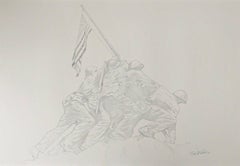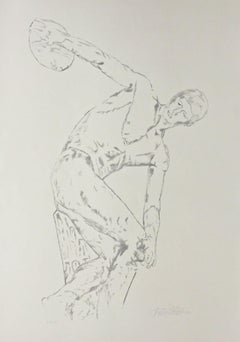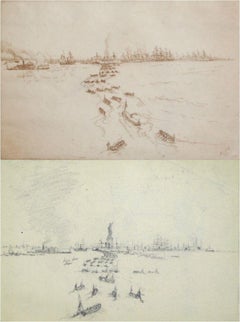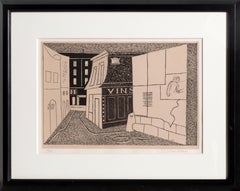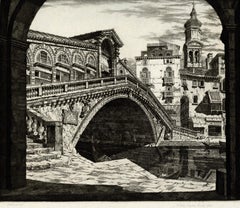Graphite Landscape Prints
to
3
5
1
1
1
1
3
Overall Height
to
Overall Width
to
8
5
3
1
1
1
1
1
1
1
1
2
3
1
3
1
1
3,451
1,937
825
244
229
Style: Modern
Medium: Graphite
Iwo Jima Memorial, Felix de Weldon
Located in Fairfield, CT
Artist: Felix de Weldon (1907-2003)
Title: Iwo Jima Memorial
Year: 2001
Edition: 2/150, plus proofs
Medium: Lithograph with graphite ink on BFK Rives cream color paper
Inscription: S...
Category
Early 2000s American Modern Graphite Landscape Prints
Materials
Lithograph, Graphite, Ink
The Lovers, Felix de Weldon
Located in Fairfield, CT
Artist: Felix de Weldon (1907-2003)
Title: The Lovers
Year: 2001
Edition: 2/10 A.P.
Medium: Lithograph with graphite ink on BFK Rives cream color paper
Inscription: Signed & numbered...
Category
Early 2000s American Modern Graphite Landscape Prints
Materials
Ink, Graphite, Lithograph
Discus Thrower, Felix de Weldon
Located in Fairfield, CT
Artist: Felix de Weldon (1907-2003)
Title: Discus Thrower
Year: 2001
Edition: 150, plus proofs
Medium: Lithograph with graphite ink on BFK Rives cream color paper
Inscription: Signed...
Category
Early 2000s American Modern Graphite Landscape Prints
Materials
Ink, Graphite, Lithograph
Characters from the Sketchbooks (from September Storm plus Self Portrait)
Located in New Orleans, LA
This is a page from the artist's sketchbooks. Six pencil drawings show figures that might have been in preparation for future lithographs, Certainly the woman with the umbrella could have been an early iteration for September Storm. There is also a self portrait of Nesbitt. Clearly the works are authentic if unsigned. Provenance: from the Nesbitt studio.
From workers wrestling with heavy machinery to a lone horseman traveling down a rut-filled country road; from the animated crowd at a livestock auction to the dignified worshippers at a serene Sunday service; Jackson Lee Nesbitt chose to represent the essence of humanity and the nobility of ordinary folk striving to get along as best they can. He studied with Thomas Hart Benton and John Demartelly...
Category
Late 20th Century American Modern Graphite Landscape Prints
Materials
Graphite
Ericsson's Day, No. 1.
Located in Storrs, CT
Ericsson's Day, No. 1. 1914. Etching. 6 x 9 (sheet 7 3/8 x 11). Printed on cream wove paper on the full sheet with deckle edges. Proof with subtle plate tone in sepia ink, printed by...
Category
1910s American Modern Graphite Landscape Prints
Materials
Etching, Pencil, Graphite
Related Items
Rue des Rats, Modernist Lithograph by Stuart Davis 1928
By Stuart Davis
Located in Long Island City, NY
A modernist lithograph by American artist Stuart Davis. In this cityscape of Paris he begins to show his inclinations towards Cubism, with the slightly skewed perspective and the fla...
Category
1920s American Modern Graphite Landscape Prints
Materials
Lithograph
Shadows of Venice
Located in Middletown, NY
Etching and aquatint on antique laid paper, wide margins. Signed, dated and inscribed "Edition of 100" in pencil, lower margin. Second state (of 2)....
Category
Mid-20th Century American Modern Graphite Landscape Prints
Materials
Aquatint, Laid Paper, Etching
Rooftops (the harbor and skyline of NYC from Brooklyn rooftop)
Located in New Orleans, LA
Moody, mysterious, majestic – these are some of the ways to describe the mezzotints of Frederick Mershimer. His images travel through the serenity of a Brooklyn neighborhood on a sti...
Category
Early 20th Century American Modern Graphite Landscape Prints
Materials
Mezzotint, Aquatint
Old Village, Modern Lithograph by Millard Sheets
Located in Long Island City, NY
Old Village by Millard Owen Sheets, American (1907–1989)
Circa 1977
Lithograph on Arches, signed and numbered in pencil
Edition of 250, AP
Image Si...
Category
1970s American Modern Graphite Landscape Prints
Materials
Lithograph
Venice from the Sea
Located in Middletown, NY
A serene landscape of the Venetian skyline at twilight.
Etching on watermarked W King cream wove paper, 3 7/8x 8 7/8 inches (97 x 212mm), full margins. An excellent and well inked i...
Category
Late 19th Century American Modern Graphite Landscape Prints
Materials
Handmade Paper, Etching
Laudation of the Art
Located in Middletown, NY
Color etching printed in gradient red, orange, yellow, green, blue, and violet ink, 8 3/8 x 15 inches (212 x 380 380 x mm), full margins. Signed, titled and numbered 46/100 in pencil, lower margin.
Arnold Gross...
Category
Mid-20th Century American Modern Graphite Landscape Prints
Materials
Color, Etching, Ink
'Mountain Trees' — 1930s Southwestern Regionalism
Located in Myrtle Beach, SC
Bertha Landers, 'Mountain Trees', etching and drypoint, c. 1938, edition not stated but small. Signed and titled in pencil.
A fine, richly-inked impres...
Category
1930s American Modern Graphite Landscape Prints
Materials
Drypoint, Etching
Prodigal Son
Located in London, GB
A fine impression with full margins published by Associated American Artists with their information label present - pictured in Art and Popular Religion in Evangelical America, 1815-...
Category
1930s American Modern Graphite Landscape Prints
Materials
Lithograph
Original "Ring It Again, Third Liberty Loan vintage WW1 poster
Located in Spokane, WA
Original poster: Ring it Again Third Liberty Loan. Buy U. S. Gov't Bonds. World War 1 lithograph poster over 100 years old. It is mounted on acid-free archival linen. It looks l...
Category
1920s American Modern Graphite Landscape Prints
Materials
Lithograph
Down the River
Located in London, GB
A fine impression of this popular Benton image with good margins.
Category
1930s American Modern Graphite Landscape Prints
Materials
Lithograph
'Financial District', New York City — 1930s American Modernism
Located in Myrtle Beach, SC
Howard Cook, 'Financial District', lithograph, 1931, edition 75, Duffy 155. A fine, richly-inked impression, on cream wove paper, the full sheet with wide margins (2 3/4 to 5 5/8 inches), in excellent condition. Image size 13 5/16 x 10 3/8 inches (338 x 264 mm); sheet size 23 x 16 inches (584 x 406 mm). Matted to museum standards, unframed.
Literature: 'American Master Prints from the Betty and Douglas Duffy Collection', the Trust for Museum Exhibitions, Washington, D.C., 1987.
Collections: Crystal Bridges Museum of American Art, Library of Congress, Metropolitan Museum of Art, Philadelphia Museum of Art, Smithsonian American Art Museum.
ABOUT THE ARTIST
Howard Norton Cook (1901-1980) was one of the best-known of the second generation of artists who moved to Taos. A native of Massachusetts, he studied at the Art Students League in New York City and at the Woodstock Art Colony. Beginning his association with Taos in 1926, he became a resident of the community in the 1930s. During his career, he received two Guggenheim Fellowships and was elected an Academician in the National Academy of Design. He earned a national reputation as a painter, muralist, and printmaker.
Cook’s work in the print mediums received acclaim early in his career with one-person exhibitions at the Denver Art Museum (1927) and the Museum of New Mexico (1928). He received numerous honors and awards over the years, including selection in best-of-the-year exhibitions sponsored by the American Institute of Graphics Arts, the Brooklyn Museum, the Society of American Etchers, and the Philadelphia Print Club. His first Guggenheim Fellowship took him to Taxco, Mexico in 1932 and 1933; his second in the following year enabled him to travel through the American South and Southwest.
Cook painted murals for the Public Works of Art Project in 1933 and the Treasury Departments Art Program in 1935. The latter project, completed in Pittsburgh, received a Gold Medal from the Architectural League of New York. One of his most acclaimed commissions was a mural in the San Antonio Post Office in 1937.
He and Barbara Latham settled in Talpa, south of Taos, in 1938 and remained there for over three decades. Cook volunteered in World War II as an Artist War Correspondent for the US Navy, where he was deployed in the Pacific. In 1943 he was appointed Leader of a War Art Unit...
Category
1930s American Modern Graphite Landscape Prints
Materials
Lithograph
Mine Near Continental Divide, Black White Colorado Mountain Landscape Winter
Located in Denver, CO
Lithograph on paper titled 'Mine Near Continental Divide' by Arnold Ronnebeck (1885-1947) from 1933. Depicts a black and white winter scene of a mine in the mountains with snow on the rooftops and hillsides. Presented in a custom frame measuring 18 ¼ x 22 ¼ inches. Image size measures 10 ¼ x 14 ½ inches.
Provenance: Estate of the Artist, Arnold Ronnebeck
Expedited and international shipping is available - please contact us for a quote.
About the Artist:
Modernist sculptor, lithographer and museum administrator, Rönnebeck was a noted member of European and American avant-garde circles in the early twentieth century before settling in Denver, Colorado, in 1926.
After studying architecture at the Royal Art School in Berlin for two years beginning in 1905, he moved to Paris in 1908 to study sculpture with Aristide Maillol and Émile-Antoine Bourdelle. While there he met and befriended American modernist painter, Marsden Hartley, of whom he sculpted a bronze head that was exhibited at the Salon d’Automne in Paris in 1912 and the following year at Hartley’s solo show of paintings at Alfred Stieglitz’s Gallery 291 in New York. A frequent guest of Gertrude Stein’s Saturday "evenings" in Paris, she described Rönnebeck as "charming and always invited to dinner," along with Pablo Picasso, Mabel Dodge (Luhan) and Charles Demuth.
After the outbreak of World War I in 1914, Rönnebeck returned to Germany where he served as an officer in the German Imperial Army on the front lines. Twice wounded, including in the Battle of Marne in France, Kaiser Wilhelm II awarded him the Iron Cross. During the war Hartley fell in love with Rönnebeck’s cousin, Lieutenant Karl von Freyburg, who was killed in combat. As a tribute to Freyburg, Hartley created Portrait of a German Officer (1914) now in the Metropolitan Museum of Art in New York.
After the war Rönnebeck traveled in Italy with German writer, Max Sidow, and German poet, Theodor Daubler, doing a series of drawings of Positano and the Amalfi Coast that formed the basis for his lithographs on the subject. The death of his finacée, the young American opera singer Alice Miriam in 1922 and his own family’s increasing financial problems in post-World War I Germany led him to immigrate to the United States in 1923. After living briefly with Miriam’s family in Washington, DC, he moved to New York where he became part of the avant-garde circle around Alfred Stieglitz. His essay, "Through the Eyes of a European Sculptor," appeared in the catalog for the Anderson Gallery exhibition, "Alfred Stieglitz Presents Seven Americans: 159 Paintings, Photographs & Things, Recent & Never Publicly Shown, by Arthur G. Dove, Marsden Hartley, John Marin, Charles Demuth, Paul Strand, Georgia O’Keeffe, Alfred Stieglitz."
In New York Rönnebeck began producing Precisionist-style lithographs of the city’s urban landscapes which he termed "living cubism." Some of them were reproduced in Vanity Fair magazine. Through Stieglitz he met Erhard Weyhe head of the Weyhe Gallery who, with its director Carl Zigrosser, arranged Rönnebeck’s first solo American exhibition in May 1925 at the gallery in New York. Comprising some sixty works – prints, drawings and sculpture – the show subsequently traveled on a thirteen-month tour of major American cities. Until the end of his life, the gallery represented him, along with other American artists Adolf Dehn, Wanda Gag, Rockwell Kent, J.J. Lankes, Louis Lozowick, Reginald Marsh and John Sloan.
In the summer of 1925, as the guest of Mabel Dodge Luhan, Rönnebeck first saw Taos, New Mexico, which Marsden Hartley had encouraged him to visit. It was there that he met his future wife, Louise Emerson, an easel painter and muralist. A year later they were married in New York before relocating to Denver. He served as director of the Denver Art Museum from 1926 to 1930 where he invited Marsden Hartley to lecture on Cézanne’s art in 1928. Rönnebeck fostered the development of the museum’s collection of American Indian art and the curation of modernist art exhibitions. In addition to his work at the museum, he was professor of sculpture at the University of Denver’s College of Fine and Applied Arts from 1929 to 1935, and wrote a weekly art column in the Rocky Mountain News.
His best known Denver sculptures from the late 1920s in bronze, copper, stone, wood and terra cotta include a reredos, The Epiphany, at St. Martin’s Chapel; The History of Money (six panels) at the Denver National Bank; The Ascension at the Church of Ascension; and the William V. Hodges Family Memorial at Fairmount Cemetery. At the same time he did a series of terra cotta relief panels for La Fonda Hotel in Santa Fe, New Mexico. In the 1930s his bas-relief aluminum friezes of stylized Pueblo and Hopi Indian Kachina masks...
Category
1930s American Modern Graphite Landscape Prints
Materials
Lithograph, Paper
H 18.25 in W 22.25 in D 0.75 in
Graphite landscape prints for sale on 1stDibs.
Find a wide variety of authentic Graphite landscape prints available on 1stDibs. While artists have worked in this medium across a range of time periods, art made with this material during the 21st Century is especially popular. There are many well-known artists whose body of work includes ceramic sculptures. Popular artists on 1stDibs associated with pieces like this include Felix de Weldon , Christo, Red Grooms, and Charles Frederick William Mielatz. Frequently made by artists working in the Modern, Pop Art, all of these pieces for sale are unique and many will draw the attention of guests in your home. Not every interior allows for large Graphite landscape prints, so small editions measuring 0.01 inches across are also available
Recently Viewed
View AllMore Ways To Browse
Villa 1919 Light
Western Cattle Paintings
Alexander Mcqueen Work
American Indian Village Painting
Antique Botanical Fruit Prints
Arizona Cowboy Artist
Bayou Painting
Bouquet Of Flowers French School
Jackson Hole Paintings
Jean Lucas
Jeffrey Morgan
Louis Tyler
Maine Poster
Nelly Duhem
New York Yankees
Oil Painting Water Marsh
Painting Corset
Playing Card Print
